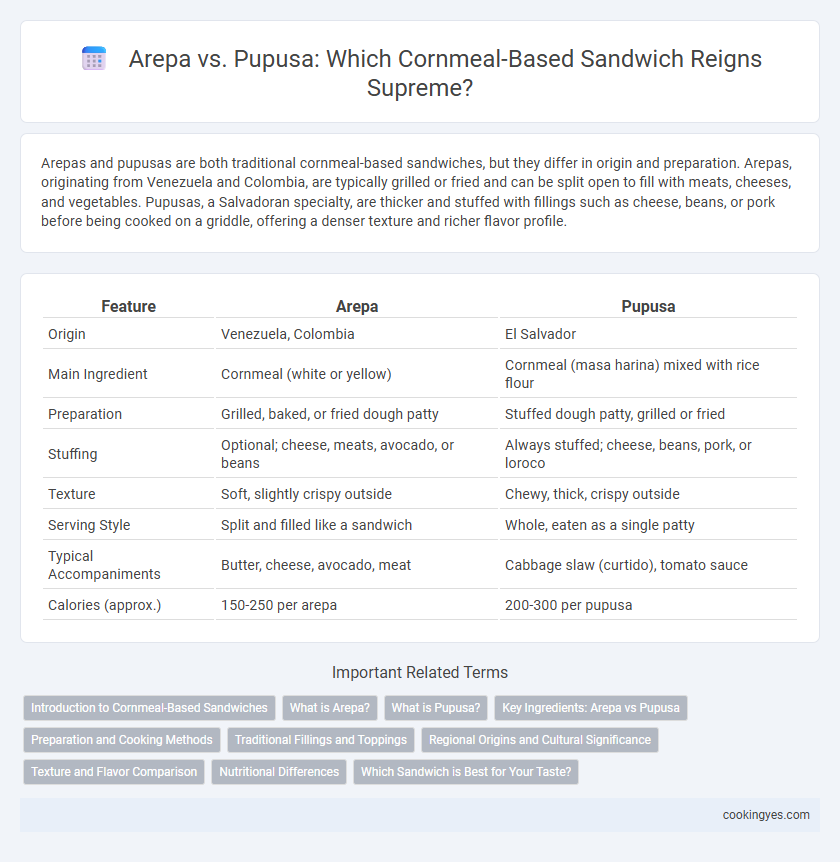Arepas and pupusas are both traditional cornmeal-based sandwiches, but they differ in origin and preparation. Arepas, originating from Venezuela and Colombia, are typically grilled or fried and can be split open to fill with meats, cheeses, and vegetables. Pupusas, a Salvadoran specialty, are thicker and stuffed with fillings such as cheese, beans, or pork before being cooked on a griddle, offering a denser texture and richer flavor profile.
Table of Comparison
| Feature | Arepa | Pupusa |
|---|---|---|
| Origin | Venezuela, Colombia | El Salvador |
| Main Ingredient | Cornmeal (white or yellow) | Cornmeal (masa harina) mixed with rice flour |
| Preparation | Grilled, baked, or fried dough patty | Stuffed dough patty, grilled or fried |
| Stuffing | Optional; cheese, meats, avocado, or beans | Always stuffed; cheese, beans, pork, or loroco |
| Texture | Soft, slightly crispy outside | Chewy, thick, crispy outside |
| Serving Style | Split and filled like a sandwich | Whole, eaten as a single patty |
| Typical Accompaniments | Butter, cheese, avocado, meat | Cabbage slaw (curtido), tomato sauce |
| Calories (approx.) | 150-250 per arepa | 200-300 per pupusa |
Introduction to Cornmeal-Based Sandwiches
Cornmeal-based sandwiches like arepas and pupusas showcase distinct regional flavors and textures rooted in Latin American cuisine. Arepas, originating from Venezuela and Colombia, are made from pre-cooked cornmeal and often split to hold various fillings, offering a crispy yet soft texture. Pupusas, from El Salvador, use a masa corn dough stuffed with cheese, beans, or meat, creating a thicker, hand-pressed sandwich that is pan-cooked until golden.
What is Arepa?
Arepa is a traditional cornmeal-based sandwich originating from Venezuela and Colombia, made from ground maize dough or precooked corn flour, often grilled, baked, or fried. Its versatility allows fillings such as cheese, meats, or beans, making it a staple in Latin American cuisine. The texture of arepas is typically thicker and denser than other cornmeal-based sandwiches like pupusas, contributing to its unique flavor and mouthfeel.
What is Pupusa?
Pupusa is a traditional Salvadoran molded cornmeal flatbread filled with ingredients like cheese, beans, or pork, offering a savory, hearty flavor. Unlike arepas, which are typically sliced and stuffed after cooking, pupusas integrate fillings during preparation, resulting in a thick, soft texture with a slightly crispy exterior. This cornmeal-based sandwich is often served with curtido, a tangy cabbage slaw, enhancing its taste and providing a distinct Central American culinary experience.
Key Ingredients: Arepa vs Pupusa
Arepas use precooked cornmeal (masa harina) combined with water and salt, forming a dough often filled with cheese, meats, or beans before grilling. Pupusas incorporate fresh masa made from ground corn, mixed with ingredients like cheese, refried beans, or chicharron, and are stuffed inside the dough rather than layered. Both rely on cornmeal, but the key distinction lies in the type of corn flour and filling method, influencing texture and flavor.
Preparation and Cooking Methods
Arepas are made from precooked cornmeal, water, and salt, formed into thick patties that are typically grilled, baked, or fried until golden and crispy on the outside. Pupusas use a similar masa harina dough but are stuffed with fillings like cheese, beans, or meat before being hand-pressed and cooked on a griddle, creating a thicker, stuffed flatbread. The cooking method for arepas emphasizes a crispy exterior with a soft interior, while pupusas require careful pressure during cooking to seal the fillings inside and achieve a tender yet slightly charred texture.
Traditional Fillings and Toppings
Arepas typically feature traditional fillings such as shredded beef, black beans, cheese, and avocado, showcasing the rich flavors of Venezuelan and Colombian cuisine. Pupusas are commonly stuffed with ingredients like refried beans, queso fresco, and chicharron, reflecting their Salvadoran heritage with a savory and hearty taste. Both cornmeal-based sandwiches highlight regional variations in fillings and toppings that emphasize local culinary traditions and textures.
Regional Origins and Cultural Significance
Arepas originate from Colombia and Venezuela, where maize is a dietary staple, symbolizing indigenous heritage and regional pride through its versatile preparation and consumption. Pupusas, native to El Salvador, are deeply embedded in Salvadoran culture, reflecting a tradition of communal cooking and celebration with fillings like cheese, beans, and pork enhancing their cultural identity. Both cornmeal sandwiches represent more than food; they are cultural icons that highlight the distinct agricultural practices and social customs of their respective regions.
Texture and Flavor Comparison
Arepas, made from pre-cooked cornmeal, offer a crispy exterior with a soft, slightly crumbly interior, providing a neutral, subtly sweet corn flavor ideal for versatile fillings. Pupusas use a fresh corn masa and are thicker, yielding a denser, chewier texture with a more pronounced corn taste often enhanced by fillings like cheese or beans. Both highlight traditional Central and South American culinary styles, but arepas emphasize a lighter crunch, while pupusas deliver rich, hearty satisfaction.
Nutritional Differences
Arepas and pupusas, both cornmeal-based sandwiches, differ nutritionally in key areas. Arepas typically contain fewer calories and less fat, made from ground maize flour and water, often filled with cheese or meats, offering moderate protein and carbohydrate content. Pupusas, made from masa harina mixed with fillings like beans, cheese, and pork, provide higher protein and fat levels due to their richer fillings, contributing to greater calorie density and increased iron and calcium content.
Which Sandwich is Best for Your Taste?
Arepas and pupusas both showcase unique cornmeal-based flavors, with arepas originating from Venezuela and Colombia, offering a crispy exterior and soft interior ideal for diverse fillings. Pupusas, traditional to El Salvador, feature a thicker, handmade cornmeal dough stuffed with cheese, beans, or meat, providing a heartier and more filling option. Choosing the best sandwich depends on whether you prefer the versatility and lighter texture of arepas or the rich, dense satisfaction of pupusas.
Arepa vs Pupusa for cornmeal-based sandwiches Infographic

 cookingyes.com
cookingyes.com